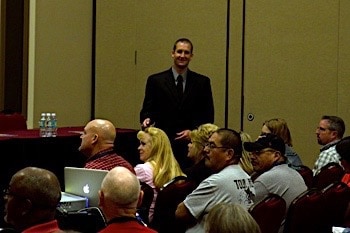A standing-room only crowd packed an STN EXPO workshop on Monday that discussed training for and responding to school-bus crash extrication and evacuation scenarios.
Lt. Paul Hasenmaier of the Huron (Ohio) Fire Department spoke on myriad topics that school district transportation departments should train on with local emergency first responders when it comes to preparing for a mass-casualty incident involving a school bus. Hasenmaier was joined by Denny Coughlin, owner of the School Bus Training Company, from Minneapolis and Cheri Clymer, a school bus safety trainer from Loveland, Colo.
Hasenmaier, who conducts school-bus training with school districts and fire departments nationwide, pointed out the numerous things that both entities must prepare for, from hazard recognition by bus drivers and students alike, to entry points into the school bus in the event of a crash, as well as how to secure a crash scene from frightened parents and the media. First and foremost, a strong incident commander needs to manage the crash scene — everything from triage and evacuation to stabilizing the bus.
Coughlin said one of the big failures by first responders, and especially law enforcement, is not blocking off a crash scene, which can include allowing traffic to continue flowing past the scene even as firefighters are attempting to cut into the school bus to extricate or evacuate passengers.
Hasenmaier shared when bus drivers should and should not evacuate students prior to the arrival of first responders. It can largely be a judgment call, which means bus drivers need training on how to recognize hazards such as fuel spills. Is the fuel spill on the bus or another vehicle? Is there an ignition source? In the case of downed power lines, the driver and students should remain on the bus until first responders and representatives of the local electrical company arrive to the scene.
It may not always be necessary for students to evacuate the bus following an accident. Hasenmaier said it depends on the severity of the crash and the injuries sustained. He advised that if students are not in imminent danger, it is likely best to wait for first responders to arrive to assess the situation. Clymer said some weather events, such as tornados, could require school bus drivers to evacuate students to a low-lying area. She pointed out the absolute wrong response to encountering a tornado is to drive the bus and park it beneath an overpass. The wind forces can suck a bus right out from under the overpass and “crush the bus like an aluminum can,” she explained.
Hasenmaier also spoke about the training that fire departments need on where to cut into the bus, how to avoid steel roof bows and where batteries in hybrid vehicles are located and how to remove them, as they can weigh as much as 1,500 pounds. He also discussed how and why firefighters should train on stabilizing school buses to protect any passengers still on board, in other vehicles or even the firefighters themselves. He also discussed the need to share information and to allow firefighters to train on how to open jammed rear or side emergency doors, how to access the front loading doors and how to remove the windshield.
Coughlin pointed out that more and more new school buses are constructed with glued-in windshields, which are removed differently than those secured with tape. While Coughlin said the newer windshields can still be kicked out, it takes more effort. Hasenmaier said some of the newer windows require saw cutting.
The very last option for extrication, said Coughlin and Hasenmaier, is cutting through the floor because of layers of steel and plywood in addition to the drive train, bolted-in seats and the fuel tank. This, they added, could take hours.
Later on Monday Clymer, Coughlin and Hasenmaier were scheduled to present on how to develop mock casuality exercises in conjunction with local first responders and other municipal resources.















